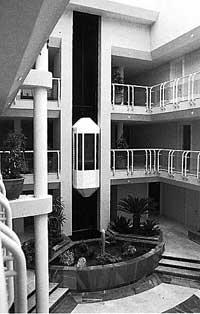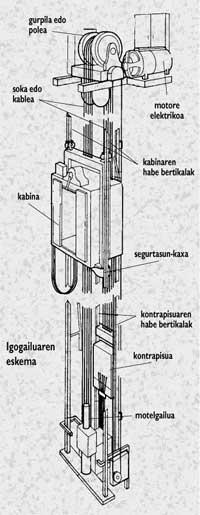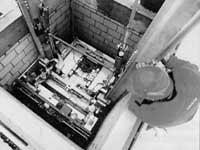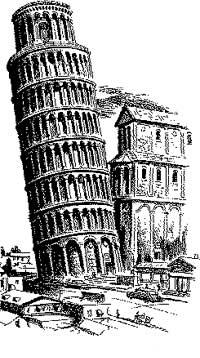Elevator Lift Elevator
1996/05/01 Irureta Azkune, Onintza Iturria: Elhuyar aldizkaria
The starting point of the elevator we know today is the wheel, the pulley, whose origin can be from the eighth century to. C. C. Among the remains of ancient mesopotamia were wooden wheels that met the pulley function, which were not used to go up and down from one plant to another, but to draw water from the wells.
A. A. C. C. In Greece of the year 400 it is known that they knew and used pulleys and strings. As for its use, it seems necessary to speak of two. And the wheels were not only used to draw water or move loads, but they also had a role in theaters. The role of the pulley was, at all, strange, to go down to the stage to the actor: it served to represent the gods who descended from heaven to the Earth to solve all the problems of the Earth.
Also in the Roman Empire they dominated the operation of the pulley. The writer Vitrubio offers in his writings magnificent explanations about the use of pulleys and how they were used at that time through animal, human and aquatic force.
As we have seen, the man has used the pulleys since time immemorial to respond to his needs, but the elevator we are studying did not reach great extensions until the replacement. The delay is due to the fact that the climbing devices of people had no destination, that is, the buildings did not have the necessary height. However, this does not mean that there has not been any kind of lift.

The lift has been used mainly for the transfer of loads and currently, in addition to for people, it is also frequently used in the naval industry. As the average height of the buildings increased, a greater need to set in motion the elevators of height and descent was detected. But let us not deceive ourselves: we also look at the economic part and until we see profitability no one dared to bet on the elevators.
Today we understand the elevator as a public service, both in public buildings and in homes. The first lift that transported passengers was private. It was launched in 1743 in the palace of Versailles for use by Louis XV, which allowed the French king to move from one floor to another with total intimacy.
On the other hand, to know the elevator that has been moved by the steam action. We had to wait until the beginning of the twentieth century. Soon the hydraulic pulleys appeared. Step by step, the elevator became more and more complex.
XIX. Until the mid-fifteenth century, except Louis XV, no one used elevators. They were not yet reliable and the risk of sinister production increased the mistrust of people. In 1853, the American Elisha Graves Otis carried out reforms to improve security measures. Four years later, in the Broadway department store the new invention was launched: the elevator went up in a minute five floors full of people. The electric motor appeared in 1889.
Numerous tests were conducted and more than one scare were suffered. But XX. At the beginning of the twentieth century, problems of safety, speed and weight had been overcome. The next step was for travelers, that is, for comfort. In this sense, it is worth mentioning the advantage of the installation of an automatic system for closing and opening cabin doors. To avoid surprises, in addition to controlling the closing speed of the doors, electric sensors (like today) were used to open immediately if something made the door difficult.
On the use of the use, the high buildings knew another advance, a vertiginous advance for the elevators. XX. Little by little, since the beginning of the twentieth century, the elevator agents began to run out of work; many hospitals, public buildings and dwellings began to install elevators with a system that kept in an electronic memory the orders given by the traveler (compressed buttons). Undoubtedly, this system which was imposed from 1915 was very important. Since it was achieved that the elevators were comfortable and with terraces of use, they were introduced in constructions of higher height, so the number of users increased remarkably. Keeping the orders saved in memory facilitates giving the answers in an order. As you enter the elevator, the passenger clicks the number of the plant to which you wish to access. It automatically orders the orders that the elevator has saved and thus executes them.
Operational

Without a doubt, we have managed to get a good game and the elevator has become something essential for many of us. But, what does the operation of this invention consist of?
At the top of the hole through which the lift is moved, the wheel or pulley tied to a bracket is an indispensable element. The rope or cable that embraces the rim transmits force to the elevator. On one end of the cable hangs the cabin and on the other the counterweight. When pulling on the side of the counterweight, the cockpit starts to climb and, if not given to the stop brake, it will climb to the top. Both up and down the distance travelled by the cabin is the same as in the cable received by the part pulled.
The function of the counterweight hanging from the other end of the cable is to balance the cabin and the weight of the passengers. Both the cockpit and the counterweight, both up and down and each one on their way, move vertically. Vertical steel beams, both on both sides, avoid sudden movements. Each time the cabin is stopped and in order to avoid a collision too strong, the elevator has dampers at its bottom, which are currently being carried out slowly but which were formerly quite violent. And today, of course, the pulley that moves the elevator and counterweight moves with electricity. The electric motor is located right next to the pulley.
Cabin, counterweight, pulley, cable ... are fundamental elements. However, there is an element that completes the complete operation of the elevator and that today is essential: the security mechanism. The lift can circulate without this small box located under the cabin, but would we be quiet passengers without safety measures? The obligation of the aforementioned safety box is simply to control the speed of the cabin.
In case of moving with previously programmed speed, the safety box will not be activated. At the time the speed increases, however, the box receives the order to cut the force that moves the elevator, to reduce the speed or stop the cabin. If the speed of the lift was not reduced, the safety brakes would be activated and therefore the cab would be stopped.
As explained, the lifts are designed to raise and lower people. But in addition to this function, they have another. In recent times, the elevators located outside the buildings and towers have proliferated. They have an aesthetic function and trips are organized to entertain travelers. The four walls of the elevator are transparent and from there you can enjoy the urban landscape. With this intention, in 1889 the access elevator was installed at the end of the Eiffel Tower.

Gai honi buruzko eduki gehiago
Elhuyarrek garatutako teknologia




